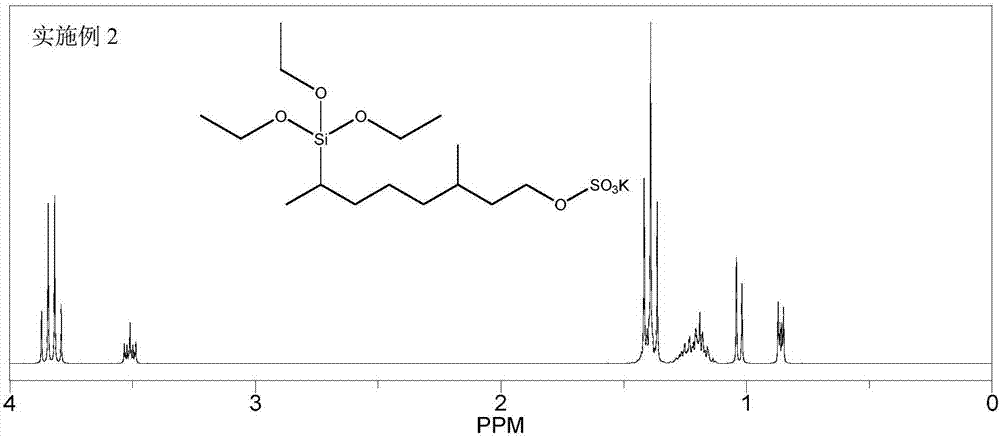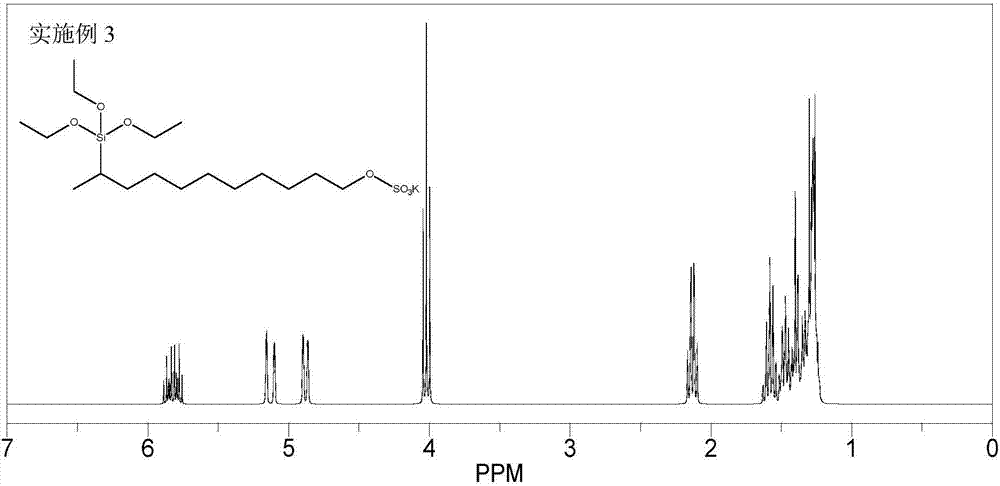An in-situ reactive concrete air-entraining agent
A reaction, carbon atom technology, applied in the field of concrete air-entraining agent, can solve the problems of unreasonable bubble size, large loss of air content, influence on strength, etc., and achieve the effect of good air-entraining effect, high air content and strong cohesion
- Summary
- Abstract
- Description
- Claims
- Application Information
AI Technical Summary
Problems solved by technology
Method used
Image
Examples
Embodiment 1
[0035] Step 1: Add 1.0 mol of 2-butenol into a reaction flask equipped with a thermometer, dropping funnel, condenser, stirrer and tail gas conduit. The temperature was raised to 30°C under stirring, and 1.1 mol of chlorosulfonic acid was added to the reaction flask within 1 h. During the dropwise addition of chlorosulfonic acid, the reaction temperature was controlled at 30-50°C. After the dropwise addition, the reaction was continued at 30°C for 30 minutes. The system was then immediately neutralized to pH=5 with NaOH.
[0036] Step 2: in the drying flask that is equipped with thermometer, condenser and stirrer, add the unsaturated alcohol sulfate that obtains in the step 1 of 1.0mol and the HSi(OCH 3 ) 3 . The temperature was raised under stirring, and when the temperature reached 50°C, 0.07ml of 0.01mol / L isopropanol solution of chloroplatinic acid (amount of 1 ppm) was added dropwise, and the temperature was controlled at 50-80°C during the dropwise addition. After t...
Embodiment 2
[0040] Step 1: Add 1.0 mol of 3-methyl-7-heptenol into a reaction flask equipped with a thermometer, dropping funnel, condenser, stirrer and tail gas conduit. The temperature was raised to 30°C with stirring, and 1.2 mol of chlorosulfonic acid was added to the reaction flask within 1 h. During the dropwise addition of chlorosulfonic acid, the reaction temperature was controlled at 30-60°C. After the dropwise addition was completed, the reaction was continued at 50° C. for 10 minutes. The system was then immediately neutralized to pH=6 with KOH.
[0041] Step 2: in the drying flask that is equipped with thermometer, condenser and stirrer, add the unsaturated alcohol sulfate that obtains in the step 1 of 1.0mol and the HSi(OCH 2CH 3 ) 3 . Heat up under stirring, when the temperature reaches 50°C, add dropwise 0.9ml of 0.01mol / L isopropanol solution of chloroplatinic acid (amount of 10ppm), and control the temperature at 50-100°C during the dropwise addition. After the drop...
Embodiment 3
[0045] Step 1: Add 1.0 mol of undecenyl alcohol into a reaction flask equipped with a thermometer, dropping funnel, condenser, stirrer and tail gas conduit. The temperature was raised to 30°C under stirring, and 1.0 mol of chlorosulfonic acid was added to the reaction flask within 1 hour. During the dropwise addition of chlorosulfonic acid, the reaction temperature was controlled at 40-60°C. After the dropwise addition, the reaction was continued at 60°C for 60 min. The system was then immediately neutralized to pH=7 with KOH.
[0046] Step 2: in the drying flask that is equipped with thermometer, condenser and stirrer, add the unsaturated alcohol sulfate that obtains in the step 1 of 1.0mol and the HSi(OCH 2 CH 3 ) 3 . Heat up under stirring, when the temperature reaches 50°C, add 11.8ml of 0.01mol / L isopropanol solution of chloroplatinic acid (amount of 100ppm) dropwise, and control the temperature at 60-90°C during the dropwise addition. After the dropwise addition, t...
PUM
| Property | Measurement | Unit |
|---|---|---|
| particle diameter | aaaaa | aaaaa |
Abstract
Description
Claims
Application Information
 Login to View More
Login to View More - R&D
- Intellectual Property
- Life Sciences
- Materials
- Tech Scout
- Unparalleled Data Quality
- Higher Quality Content
- 60% Fewer Hallucinations
Browse by: Latest US Patents, China's latest patents, Technical Efficacy Thesaurus, Application Domain, Technology Topic, Popular Technical Reports.
© 2025 PatSnap. All rights reserved.Legal|Privacy policy|Modern Slavery Act Transparency Statement|Sitemap|About US| Contact US: help@patsnap.com



